By Gary Schnitkey and Nick Paulson et.al
Department of Agricultural and Consumer Economics
University of Illinois
By Carl Zulauf
Department of Agricultural, Environmental and Development Economics
Ohio State University
In 2020, Revenue Protection (RP) was used on 93% of insured acres in Illinois, making it by far the most popular crop insurance product (farmdoc daily, November 17, 2020). Herein, we examine coverage levels while insuring with RP. Average coverage levels were high. Most farmers choose coverage levels such that premiums are between $15 and $23 per acre.
Coverage Levels in Illinois
The highest RP coverage level is 85%, with lower coverage levels available in 5% increments down to 50%. In 2020, 44% of RP corn acres in Illinois were insured at an 85% coverage level, 35% at an 80% coverage level, and 16% at a 75% coverage level (see Figure 1). These three higher coverage levels accounted for 95% of the acres insured by RP.
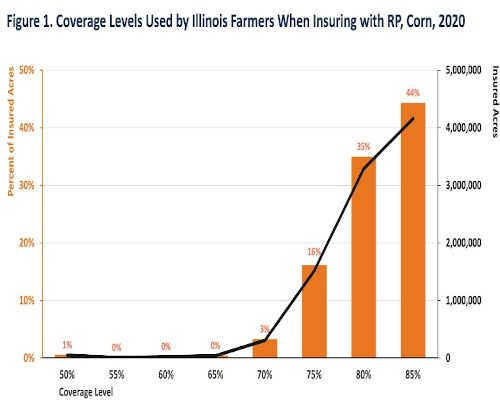
Average coverage levels were calculated to summarize information. For example, the coverage-level information in Figure 1 was used to arrive at an average coverage level for corn in Illinois. In 2020, the average coverage level was 81%, with weights provided by acres insured. As can be seen in Figure 1, the 81% is composed of 44% of acres insured using an 85% coverage level, 35% at an 80% coverage level, and so on. Average coverage levels over 80% imply that the majority of acres were insured with 80% and 85% coverage levels.
Average coverage levels in Illinois have increased since the introduction of revenue products in 1997, reaching their current level in 2013. The average coverage level since 2013 has been stable at 81%.
While stable over time, the average coverage level varies across the state (see Figure 2). In 2020, most counties in northern and central Illinois had average coverage levels above 80%. Most counties in southern Illinois had average coverage levels below 80%.
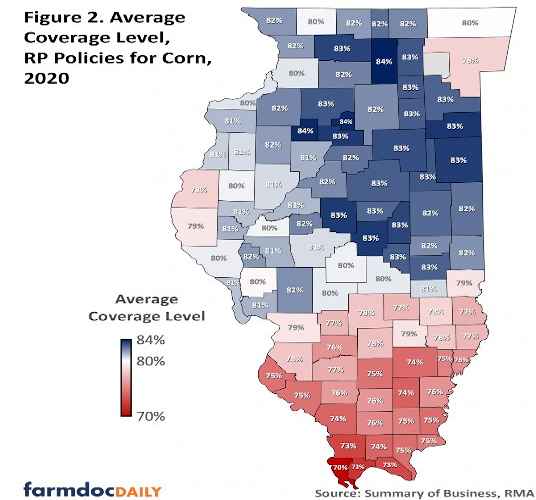
Relationships Between Average Coverage Levels and Premiums
Counties with higher coverage levels tend to have lower premiums than counties with lower coverage levels. To illustrate, Figure 2 shows farmer-paid premium for RP policies with 80% coverage levels. As can be seen in Figure 2, lower premiums occur in northern and central Illinois where average 80% premiums are usually between $7 and $14 per acre. Northern and central Illinois tend to have high coverage levels. On the other hand, many counties in southern Illinois had average premiums for 80% RP over $20 per acre. Southern Illinois tended to have lower average coverage levels.
The regional patterns suggest that farmers may make their coverage level choice to even out, or budget, their farmer-paid premium. Figure 4 shows average farmer-paid premium over all coverage level choices. The average premium in Figure 4 tend to even out over Illinois much more than the 80% premium shown in Figure 3.
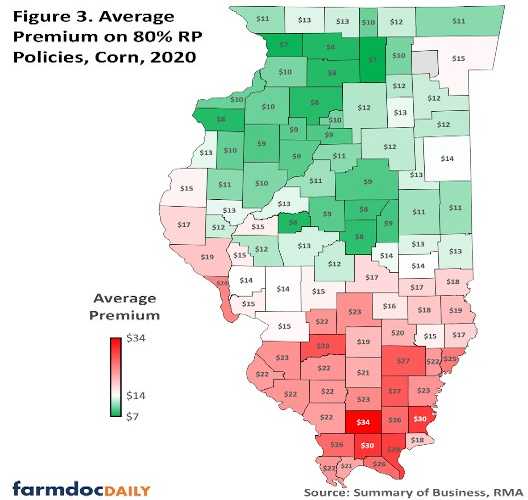
To illustrate the budgeting process, take two counties that have their premiums colored orange in Figure 4. DeKalb County is in northern Illinois and had an average premium across all coverage levels of $12 per acre. The 80% average premium was $7 per acre. In DeKalb County, a higher proportion of farmers took 85% coverage levels, thereby raising the average premium above the 80% premium. The average coverage level in DeKalb County was 84%, meaning that the vast majority of farms take RP at a 85% coverage level (see Figure 1). On the other hand, Jefferson County in southern Illinois had an average premium across all coverage levels of $17 per acre. An 80% coverage level had an average premium of $21 per acre. More farmers in Jefferson bought lower coverage levels y resulting in an average coverage level of 75% (see Figure 1).
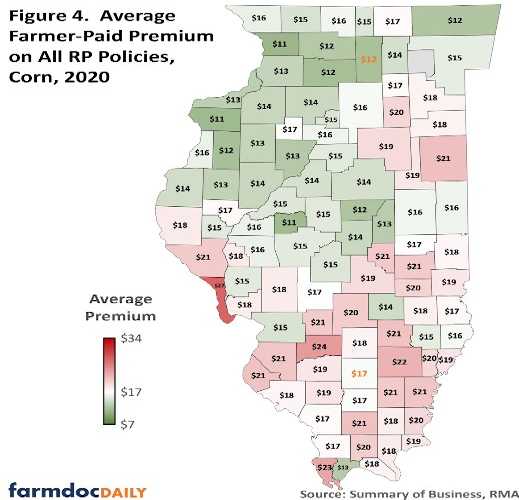
Academic literature has evaluated this phenomenon (Bulut). Most farmers will only spend a certain amount on crop insurance. Values in the above figures suggest that many farmers will not spend over $15 to $23 per acre on crop insurance. Of course, variation in spending exists across farmers.
Average Coverage Levels Across the Midwest
Average coverage levels across the Midwest States are shown in Figure 4 for corn. Higher average coverage levels are located in the heart of the corn belt, with lower coverage levels radiating out from the middle of the Corn Belt. The correlation coefficient between average coverage levels and average premiums is -0.61. While that correlation is high, other factors influence coverage levels choice across the Midwest.
Commentary
Many farmers have settled on using RP at high coverage levels as their crop insurance coverage. Many farmers appear to make coverage level choices so as to keep premium levels below $15 to $23 per acre. Product type and coverage levels have been stable over several years. Crop insurance choices in 2021 likely will be much the same as those made in 2020.
This year, a new endorsement is available called the Enhance Coverage Option (ECO). ECO will provide county revenue coverage above the underlying RP policy in a band from 90 or 95% down to 86% . One challenge this policy will face is premium costs. Aggregate statistics suggest that farmers place constraints on the amount they spend on crop insurance. Those constraints may prevent many farmers from buying the additional coverage. Purchases of ECO may be more likely in northern and central Illinois where premiums are lower.
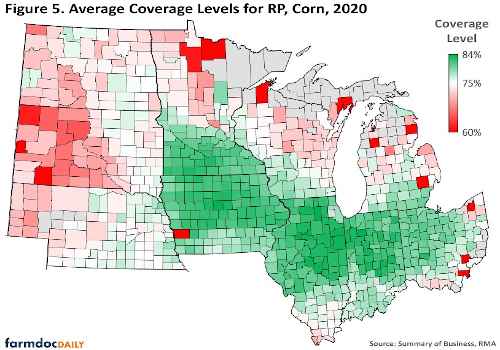
Source : illinois.edu